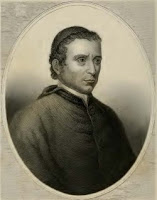Pruned of its New Yorker chattiness, the first part of the article gives interesting information about famous polyglots in the past:
* According to Pliny the Elder, the Greco-Persian king Mithridates VI, who ruled twenty-two nations in the first century B.C., administered their laws in as many languages, and could harangue in each of them.
* Plutarch claimed that Cleopatra very seldom had need of an interpreter, and was the only monarch of her Greek dynasty fluent in Egyptian.
* Elizabeth I also allegedly mastered the tongues of her realm—Welsh, Cornish, Scottish, and Irish, plus six others [including the language of her enemy, Spanish].
* The prowess of Giuseppe Mezzofanti (1774-1849) is more astounding and better documented. Mezzofanti, an Italian cardinal, was fluent in at least thirty languages and studied another forty-two, including, he claimed, Algonquin. In the decades that he lived in Rome, as the chief custodian of the Vatican Library, notables from around the world dropped by to interrogate him in their mother tongues, and he flitted as nimbly among them as a bee in a rose garden.
* Thurman misses out the 18th-century English orientalist and translator Sir William Jones, who was reputed to know 26 languages.
Those were champions, so-called hyperglots. Their achievement was the fruit of many years of learning. But scarcely less remarkable is the achievement by the little girl Bella Devyatkina who was described last month on this blog and who could converse in seven languages at the age of four. Yet the underlying reason why all of them could do what they did is the same. It’s that human psychology and the physical human brain are built from infancy, perhaps from birth, for multilingualism (bilingualism being a special case of multilingualism and not the other way round.) Bella’s mother insists that her daughter, for all her precocity, is not a genius. It’s just that she has been put in situations and relationships where she responds to the motivation of receiving a present from speakers of other languages.
Scientists and philosophers agree that language is one of the marvels of human evolution, No other animals have anything comparable. To it has been added another evolutionary marvel: the ability to learn multiple languages. The examples quoted above suggest that in principle there is no limit to their number. Yes, there are practical limits; the time we can devote to learning them and the length of our lives for instance, and the amount of contact we have with other-language speakers . And there are also psychological constraints, in particular motivation, without which we may be unwilling to work at it. But not the structure of our minds.
There are different degrees of multilingualism, which makes it difficult to compare polyglots. Full multilingualism requires much more than knowing the grammars and vocabularies of the languages. The functioning multilingual can do the following:
a) Keep the languages separate. Actually very young bilinguals are prone to mixing their languages in the same sentence or utterance, a phenomenon linguists call code switching. Typically this weakness disappears around age three, but vestiges of it remain throughout life. We multilinguals are all used to occurrences of leakage or interference between our languages; for instance the common phenomenon of false friends. However, they dwindle to a frequency where they don’t hamper communication.
Just how the separation is maintained is a matter of disagreement. Some psycholinguists believe we keep our languages in separate drawers, as it were, and take them out and activate them as we need them. Others think that on the contrary they are all present in our working minds but we suppress the ones we don’t need at the moment.
b) Switch between the languages. This may be done at will and almost instantaneously; or the switch may be triggered automatically by a stimulus, for instance when answering a question in the language in which it is asked.
c) Use the languages appropriately to express the thoughts we want to convey or to understand what others are telling us. It may be, however, that we aren’t equally competent at this in all our languages; it depends very much on the experience we’ve had in using them.
d) Use the languages in ways that are appropriate for the speaker/writer and for the addressee. For more about it and the weakness of machine translation in this respect, enter pragmatics in the Search box on the right.
There are several ways in which we can learn languages. For example, “Mezzofanti, the son of a carpenter, picked up Latin by standing outside a seminary, listening to the boys recite their conjugations.” I learnt my mother language, English, unconsciously and effortlessly from birth as I’m sure you did; three languages (French, German, Latin) in compulsory formal courses at school from age 11; one (Arabic) in formal university courses from age 18 because I was interested in it and thought it would help me get a job; and two others later (Spanish and Valencian) without ever taking a course in them but from elementary teach-yourself books and everyday conversation with native speakers with whom I was working. Apart from English, age had little to do with it. If I went to live in another country, even at my advanced age, I wouldn’t hesitate to learn its language. Of course, as with any natural skill, there is a pathology: a minority of people may have learning problems, and language learning becomes more difficult, requires more conscious effort, once the stage of early plasticity is passed. It has seemed to me, though, that most of my English and Canadian compatriots who say they can’t learn a foreign language are like people who don’t learn to swim because they’re afraid of the water.
Sources
Judith Thurman. The mystery of people who speak dozens of languages. The New Yorker, 3 September 2018. My thanks to Philippe Lambert for sending it.
William Jones (philologist). Wikipedia, 2018.
Image
Cardinal Guseppe Mezzofanti.

